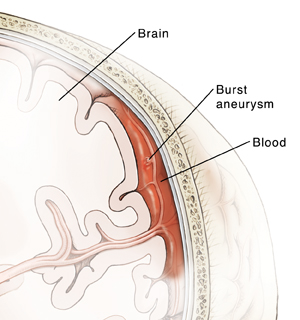Hemorrhagic Stroke: Subarachnoid Hemorrhage
Hemorrhagic Stroke: Subarachnoid Hemorrhage
A hemorrhagic stroke happens when a blood vessel in the brain ruptures or leaks. A blood vessel on the surface of the brain bursts and bleeds (hemorrhages). This spills blood into the surrounding tissue.The arachnoid is one of the 3 membranes that surround the brain. In a subarachnoid hemorrhage, the blood leaks under this membrane.
This type of stroke often happens suddenly, with little warning. It is the most serious of all types of strokes.

What happens during a subarachnoid hemorrhage?
This type of stroke happens when a major blood vessel bursts on the surface of the brain. Normally, the space between the brain and the skull is filled with a clear fluid. When the blood vessel bursts, blood flows into the space between the brain and the skull. The amount of fluid in this space increases and puts pressure on the brain. This pressure can damage nearby parts of the brain.
Most of these strokes happen when a cerebral aneurysm bursts. An aneurysm is a weak spot in the wall of a blood vessel. A bubble often forms in this weak spot. In some cases, a cerebral aneurysm causes pain or other symptoms. In most cases, though, an aneurysm causes no symptoms until it bursts.
What are the symptoms of a subarachnoid hemorrhage?
Any stroke is a medical emergency. If you have any of these symptoms, even if they seem to get better, call 911 right away:
-
Sudden, excruciating headache with no known cause
-
Nausea and vomiting (often with headache)
-
Sudden confusion or decrease in alertness
-
Trouble moving or loss of feeling, especially on the face, arm, or leg specifically on one side of the body
-
Sudden trouble walking, dizziness, loss of balance or coordination
-
Sudden trouble talking or understanding speech
-
Sudden mood changes
-
Sudden dimness, double vision, or loss of vision, particularly in one eye
-
Eyes suddenly very sensitive to light
-
Neck and shoulder pain or stiff neck
-
Seizure
How is a hemorrhagic stroke treated?
The acute phase lasts from the first minutes to hours after symptoms start. During this phase, treatment focuses on relieving pressure on the brain and preventing further damage. A procedure or surgery may be done to repair the ruptured (burst) aneurysm. A drain may be placed into the brain to relieve pressure. Medicines to control blood pressure may be given through an IV line. Seizure medicine is often given. Tests will likely be done to check for other aneurysms in the brain. If they are found, surgery may be done to reduce the risk that they will burst and bleed.
After the acute phase, treatment focuses on recovery. Long-term damage from a stroke can include paralysis, trouble speaking or understanding, and trouble thinking clearly. Rehabilitation (rehab) can help reduce these effects and regain skills. Rehab starts in the hospital and generally continues in an inpatient or outpatient facility, and eventually at home. It will focus on regaining lost skills. It may include:
-
Help regaining movement.
-
Therapy for speech and language
-
Help with swallowing
-
Help reducing risk factors for another stroke, such as smoking
In addition, medicines that help prevent another stroke may be given. These include medicines to control blood pressure and prevent bleeding.
Updated:
July 26, 2019
Sources:
An Updated Definition of Stroke for the 21st Century: A Statement for Healthcare Professionals From the American Heart Association/American Stroke Association. Sacco, R. Stroke. 2013, is. 44, ed. 7, pp. 2064-89., Treatment of Aneurysmal Subarachnoid Hemorrhage, UpToDate
Reviewed By:
Hanrahan, John, MD,Sudheendra, Deepak, MD